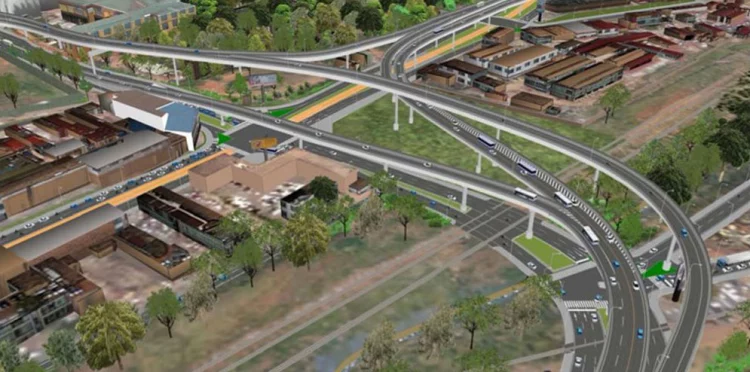- Direction country is headed: Ugandans are divided on the country’s overall direction, with half (51%) saying it is headed in “the wrong direction,” a 14-percentage-point increase since 2019. Residents are particularly critical of the country’s direction in the cities of Jinja (74%), Entebbe (69%), Masaka (62%), Gulu (62%), and Kampala (62%).
- Declining economic and living conditions: Two-thirds (66%) of citizens describe the country’s economic condition as bad, a 20-percentage-point increase compared to 2019, and 58% offer negative assessments of their personal living conditions, up 17 points compared to pre-COVID-19 ratings recorded in 2019. While views on personal living conditions vary widely across the new cities, majorities in all cities describe the country’s economic condition as bad.
- Government economic performance: Citizens’ assessments of the government’s performance on key economic tasks have declined sharply since 2015. Only small minorities give the government passing marks on keeping prices stable (12%), narrowing gaps between the rich and poor (14%), creating jobs (22%), improving the living standards of the poor (25%), and managing the economy (33%).
- Citizens’ development agenda: Health, education, infrastructure/roads, and water supply have dominated Ugandans’ list of the most important problems requiring government action since 2015. Residents in each city have their specific set of priorities, but health tops the list in most cities.
- Lived poverty: Seven in 10 Ugandans (70%) experienced moderate or high levels of lived poverty, a substantial increase from the 64% recorded in 2019, before COVID-19. Citizens residing in cities experience poverty at similar rates as those in their respective subregions, with the highest rates recorded in Jinja (81%), Arua (77%), Hoima (75%), and Entebbe (75%).

On 1 July 2020, less than a year before January 2021 presidential and parliamentary elections, Uganda’s minister of local government, acting under the Local Governments Act and with the approval of Parliament, elevated 10 of the 15 earmarked municipal councils across the country to city status (Parliament of the Republic of Uganda, 1997, 2020). City status, equal in stature to district local government status, is the highest level that local government units can attain under the current law and is synonymous with near-autonomy, including significant political influence and more control over resource mobilisation and use.
Residents in the newly elevated city environs celebrated this administrative milestone amid surging expectations of immediate upgrades of public-services infrastructure and jobs. But the respective administrations awoke to the realities of over-stretched, outdated services infrastructure, and inadequate funding incapable of meeting the heightened level of demand.
Can these new cities fulfil their mandate – even in the face of COVID-19-related impacts on the economy and personal living conditions – and cope with soaring public expectations? Evidence from the 2022 Afrobarometer survey suggests that it will not be easy, as the public mood, engagement with elected local leaders, and public service-delivery ratings are on the decline while mistrust, perceptions of official corruption, and resentment toward paying taxes are on the rise.
This policy paper makes a case for the creation of the 10 regional cities, especially because urban centres tend to spur socio-economic development (Lall, Lebrand, Park, Sturm, & Venables, 2021). But it also explores ways in which the new cities can prioritise their development planning. The country would benefit from having more functional urban, especially since residents in urban areas are more attuned to the ideals of democratic governance (Mattes, 2019), tend to engage more in civic action (Logan, Appiah-Nyamekye, & Han, 2021; Lekalake & Gyimah-Boadi, 2016), and are more likely than their rural counterparts to access public services infrastructure such as health, education, markets, roads, electricity, and financial services (Mitullah, Samson, Wambua, & Balongo, 2016).
Thus, the government’s abrupt decision to prioritise expanding urban centres appears to have energised the masses, especially given Uganda’s (and Africa’s) changing and youthful demographic outlook. Global urbanisation trends indicate that Africa has the world’s fastest- growing population (United Nations, 2019; OECD, 2020) and that by 2040, at least half of the continent’s population will reside in cities (World Bank, 2013). In addition, Uganda’s mushrooming urban centres are becoming hubs for social and economic opportunities (European Union, 2019). The challenge for new African cities lies in proper planning and funding to create liveable environments.
While urbanisation may facilitate meeting certain targets of the 2030 and 2063 development agendas (United Nations, 2015; African Union, 2015), constraints in development planning and resource mobilisation have hindered Uganda’s rapidly growing urban centres from achieving their full potential in terms of structural transformation, expanded formal employment opportunities, socio-economic growth, and the creation of sustainable liveable environments. According to the National Planning Authority (2013, 2020), Uganda’s current urban growth – including many unemployed people and refugees – is unsustainable due to chronic deficiencies in the quantity and quality of social services and inadequacies in physical planning and implementation.
Uganda’s rapid population increase has dramatically increased pressures on public services infrastructure in the capital city, fuelling calls to create subregional cities to spur regional development and reduce uncontrolled rural-urban migration.
In response to these pressures, and in line with United Nations Sustainable Development Goal 11’s call for urban communities that are “inclusive, safe, resilient and sustainable,” the government adopted the Uganda Vision 2040, premised on, among other things, the need for controlled urbanisation (freeing up land for commercial agriculture), stable higher
incomes, and stronger institutions through legislation and integrated physical planning (National Planning Authority, 2013, 2020).
Under a two-phase city-upgrade implementation plan (Table 1 below), 15 municipal councils were to be elevated to city status by 1 July 2023. The first phase involved creating the 10 cities of:
- Arua, Gulu, and Lira in the Northern region
- Soroti, Mbale, and Jinja in the Eastern region
- Masaka in the Central region
- Mbarara, Fort Portal, and Hoima in the Western regionThis brought the number of cities in the country to 11, including Kampala, the capital. The first phase created 10 new city administrations, 352 new town councils, and 364 new sub-county administrations, with local council elections held a year later during the 2021 general elections.
The second and third phases, planned to be completed by 1 July 2023, were to upgrade five more municipal councils:
- Entebbe, Nakasongola, and Wakiso in the Central region
- Moroto in the Karamoja region
- Kabale in the Western region
However, in April 2021 the line minister issued a moratorium on the creation of any new local government administration units, citing a widening funding gap for lower local governments (Opoka, 2021; Muhereza, 2023). Debate rages over this near-fiasco of the government creating so many administrative and elective positions that the country lacked the resources to sustain (Mbabazi & Atukunda, 2020).
Proponents maintain that this government action was justified by Uganda’s population growth and the imperative to bring services closer to the people. Census and population estimates indicate that Uganda’s population more than doubled between the 1991 census and the 2021 elections, from 16 million to almost 42 million. The number of district local governments almost quadrupled, from 38 units in the 1991 census to 146 by 2020 (Table 2). The government defended the new cities as necessary to keep pace with service-delivery demands at the subregion level, provide alternatives to urban migration and decongest Kampala, create regional economic hubs, and institutionalise the regional-tier system to assuage voices agitating for federalism (Rukundo, 2020).
However, dissenting voices argue that the government should not start a city without a proper plan (Muhumuza, 2020; Kyohairwe, 2020); some contend that the new cities were born of election fever, patronage, and clientelist tendencies aimed at winning the elections (Green, 2008). Critics say the elevation of the municipal councils came ahead of its time, considering resource-mobilisation constraints at the central government level and the inability of local governments to raise sufficient local revenue sustainably (Wambede et al., 2021).
As shown in Table 3, the districts where the new cities are the regional business centres are on average one-eighth Kampala’s size in population, with one-fifteenth of its GDP, but are twice as large in terms of planning area size, making it a daunting task to roll out public service infrastructure.
As the newly installed city administrations reorient their service-delivery plans to match heightened citizen expectations, it is hoped that this paper’s city-by-city disaggregation of citizen views on key issues – including the interaction between measures of contentment with local government services and views on quality, integrity, and poverty – can help provide clues for identifying medium- and long-term solutions.
